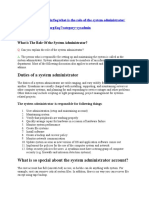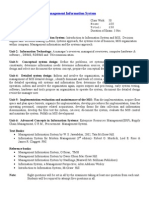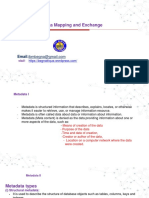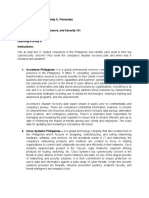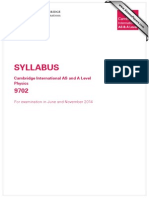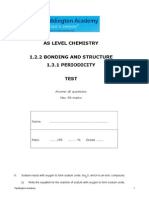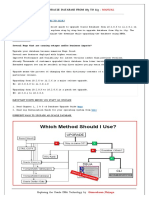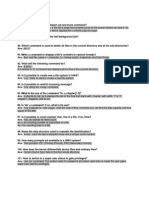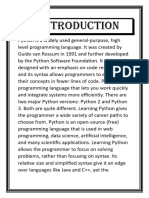Uses of ICT in Data Management
Uses of ICT in Data Management
Uploaded by
Mišel VuittonCopyright:
Available Formats
Uses of ICT in Data Management
Uses of ICT in Data Management
Uploaded by
Mišel VuittonOriginal Description:
Copyright
Available Formats
Share this document
Did you find this document useful?
Is this content inappropriate?
Copyright:
Available Formats
Uses of ICT in Data Management
Uses of ICT in Data Management
Uploaded by
Mišel VuittonCopyright:
Available Formats
Uses of ICT in data management
Database (system) collection of related data, such as records and fields the simplest form a database is consist of. Each record contains the same set of fields (each of them contain one piece of information). Database management system (DBMS) software used to manage a database system. IT MANAGES: 1. 2. 3. 4. The structure of the individual data files The relationships between data items and between data files How the data is interrogated (i.e. how you get information from the database) The properties of the database, i.e. ensuring that all queries, updating and amendments to structure are processed realiably. SEQUENTIAL FILES Records are stored one after the other, in the order in which they were added to the storage medium, usually magnetic tape Used for reading the data from the tape, or writing on it.
TWO WAYS that records can be arranged in sequential file Having the records in some sort of order using a key field (unique to every record, i.e. every record has a different value in that field) ORDERED SEQUENTIAL (the records are put in order of a key field such as customer ID) The records might be arranged with no thought given to their order so they appear to be UNORDERED (often reffered to as serial files retrieving information by going through each record one by one)
DISADVENTAGES of using sequential fiels: o The only way to add new records to a sequential file is to store them at the end of the file. o A record can only be replaced if the new record is exactly the same length as the original. o Records can only be updated if the data item used to replace the existing data is exactly the same length. o Processing of records in a sequential file is slower than with other types of file. o Have to be read in sequence until you get to the one u want. o Recommended for applications where most or all the records have to be processed at one time.
o Deleting or amending records is not easy. ( If it is an ordered sequential file, then the changes can be made relatively easily, providing transription file) Transcription file- contains the actions to be carried out on the records has been sorted into the same order as the master file, using the key field. Below this level are master file and a transaction file. Types of TRANSACTION: 1. D deletion of 2. C change to 3. A an addition of a record. Transaction is NOT succsessful if: the first record in the transaction file and the first record in the old master file doen't match ( the ID's don't match )
INDEXED SEQUENTIAL AND RANDOM ACCESS FILE -
Indexed sequential files are stored in order.
Indexed sequential files are stored on the disk to enable some form of direct access. Each record consists of fixed length fields and each kas a key. With an Index sequential system the records are in some form of order.
Index a pointer to whereabouts on the disk the record is stored Banks use sequential access systems for batch processing cheques. This system would have to be at least indexed sequential for faster access to records for online banking. Indexed sequential files are used with hybrid batch-processing systems, such as employee records. -
Random access is the quickest form of access
Doesn't matter whereabouts in the file the desired record is, it will take the same amount of time to access any particular record. Each record consists of fixed length fields and each kas a key. The computer looks up the key and goes to the appropriate place on the disk to access it. HIERARCHAL DATABASE MANAGEMENT SYSTEMS
Hierarchal DBMS are no longer used as a form of file management to any extent, as they suffer from the problem of one-way relationships. They use a tree-like structure similiar to a family tree system. Few records/files at the TOP, but many BELOW the structure. Main usage in File organisation within computer directory structures.
Folder ''Users'' in a typical Windows system can have several users within it and they in turn can have several documents stored within each user. Enables fast access to data however, as large amounts of data are bypassed as you go down the levels. NETWORK DATABASE MANAGEMENT SYSTEMS
Network DBMS were developed to overcome a lot of the faults of hierarchical type. Parts of the database are usually stored on a number of computers that are linked through a WAN or LANs. Many of the parts are duplicated unlikely that any data is lost; faster processing complex searches or filters. Appears to each user as a single system. Another type of NDBMS is stored on one device, but can be accessed from a number od network locations through either LAN / WAN. Users of the database can access the system simultaneously without affecting the speed of accesssing data.
Examples of this type are the Police National Computer (PNC) & Driver and Vehicle Licencing Authority (DVLA) in the UK. Bothe of them can be accessed by police officers from their cars.
RELATIONAL DATABASE SYSTEMS Consists of number of separate tables that are related in some way. Each table has a key field that is a field in at least one other table. Data from one table can be combined with data from another table when producing reports. Possible to select different fields from each table for output, using a key field as a reference point. Relational tables could be used to represent data from a payroll aplication & human resources app.
The standard programming language in large applications to deal with relational tables is the structured query language (SQL) used for queries & producing reports. ADVENTAGES: Data is not repeated (doesn't waste valuable storage capacity Data is in separate tables connected by the keyfield (i.e. worker number) Data retrieval quicker Reduce risk of hackers having easier access to personal data. Room for expansion is allowed extend the database with other data/tables.
PAYROLL APPLICATIONS Normally involve the use of batch processing (files needed are stored on separate magnetic tapes) Two data files involved first one is master file & transaction file; master file Master file (holds all the data about the workers; includes the employee number, their name, contact details, rate of pay and the pay they have recieved so far this year as well as the taxes, national insurance number and so on. Transaction file (contains less data; temporary file as it contains some data which can change from week to week, or month to month; contains number of hours worked & ofcourse the employee number; also has details of any new workers or workers who have left the company or any worker whose details are changed.
-The computer calculates the pay of each worker using the number of hours worked contained in the transaction file, and the rate per hour from the master file. -Payslips are then printed, together with reports showing overall statistics as well as error reports. -Records from the old master file are updated using these calculations and any deletions, additions or ammandements are made. -These records are written to a new tape which becomes the new master file.
Reports consists of: 1) financial reports 2) error reports 3) payslip The old master file contains the data that was up to date.
The UPDATE process involves: Calculation of the employee's wage for this week/month using the hours worked from the transaction file. The wages calculated together with National Insurance payments and tax payments. These values used to bring the year-to-date totals up to date The following week the NEW master file becomes the OLD master file. PAYSLIPS Contains information that can be found on the new master file & transaction file. Creating the payslips we need master file data linked with transaction file containing the employee number and hours worked. FINANCIAL REPORTS Most payroll software has a report generatior facility. Provides detailed payroll listings & exception reporting.
Examples of typical reports: o o o o o o o o Information about all employees of the company Information about employees in a given department Information about the salaries of all employees National Insurance contributions for all employees The total amount of National Insurance contributions paid to the tax authorities The income tax that each employee has paid The total amount of income tax paid to the tax authorities The amount of money paid to each bank that employees have an account with
EXCEPTION REPORTS Reports of certain validation rules being broken are also produced from the system. An employee earning an unusually large amount of money An employee who has been on an emergency tax code for a long period of time Two employees having the same National Insurance number. TECHNICAL & CUSTOMER SUPPORT Use of call centres. Large office space (housing as many as 100 operators, is used for the purpose of taking calls & responding to requests for help). Each operator sits at a desktop computer that is connected via telephony server to the company's phone line. Each computer has a headset (integrated headphones ans microphone) connected to. Operator's computer must be fitted with computer telephony cards.
You might also like
- Kenpo Journal User GuideDocument31 pagesKenpo Journal User GuideJuan C Lastra D100% (5)
- The Disease The Cure Imam Ibn Al Qayyim Compressed - CroppedDocument553 pagesThe Disease The Cure Imam Ibn Al Qayyim Compressed - CroppedMišel Vuitton100% (1)
- 6th Central Pay Commission Salary CalculatorDocument15 pages6th Central Pay Commission Salary Calculatorrakhonde100% (436)
- CMPE 30052 - Data Structures and Algorithm - PUP OBE Syllabus - For Revised Curriculum 2018 - SAMPLE TEMPLATESDocument8 pagesCMPE 30052 - Data Structures and Algorithm - PUP OBE Syllabus - For Revised Curriculum 2018 - SAMPLE TEMPLATESjscansinoNo ratings yet
- THESIS Documentation (DRAFT)Document29 pagesTHESIS Documentation (DRAFT)Angelica HermosaNo ratings yet
- Chapter 1Document9 pagesChapter 1Andeng AnceroNo ratings yet
- SEAIT Guidance Office Profilling System (Sgops) : College of Information and Communication TechnologyDocument6 pagesSEAIT Guidance Office Profilling System (Sgops) : College of Information and Communication TechnologyJohanie BalicucosNo ratings yet
- Document Accessibility Guide Microsoft WordDocument8 pagesDocument Accessibility Guide Microsoft Word03sri03No ratings yet
- Data Integrity ChecklistDocument5 pagesData Integrity Checklistfdsdfsdf100% (1)
- Chapter 1 CapstoneDocument22 pagesChapter 1 CapstoneRenzo BrojanNo ratings yet
- Web-Based Document Tracking and Management System of The Department of Public Works and Highways (DPWH), Laguna Ii District Engineering Office, Los Baños, LagunaDocument1 pageWeb-Based Document Tracking and Management System of The Department of Public Works and Highways (DPWH), Laguna Ii District Engineering Office, Los Baños, LagunaKelly FrederickNo ratings yet
- SBM Tool-For AssessmentDocument16 pagesSBM Tool-For AssessmentBetty BlascoNo ratings yet
- Sample Implementation PlanDocument19 pagesSample Implementation PlanEdith FauniNo ratings yet
- Mis - Privacy IssuesDocument24 pagesMis - Privacy IssuesJeffin Jose0% (1)
- Letter Seeking Technical SupportDocument10 pagesLetter Seeking Technical Supportlouiegi001No ratings yet
- Technology Needs AssessmentDocument7 pagesTechnology Needs AssessmentMichael King100% (2)
- Review of Related Literature Management Information SystemDocument3 pagesReview of Related Literature Management Information SystemZelop DrewNo ratings yet
- Capstone Document Guide - 2022Document22 pagesCapstone Document Guide - 2022Leary John TambagahanNo ratings yet
- For KIOSK (Student Respondents) : WITH SMS NOTIFICATION in Terms of Functionality, Efficiency, Usability, Reliability, andDocument2 pagesFor KIOSK (Student Respondents) : WITH SMS NOTIFICATION in Terms of Functionality, Efficiency, Usability, Reliability, andRomeo BalingaoNo ratings yet
- Bsit Practicum 1 Portfolio Template 3Document8 pagesBsit Practicum 1 Portfolio Template 3Katya TarigaNo ratings yet
- Self Study BSITDocument186 pagesSelf Study BSITVladimir Cudris0% (1)
- Dokumen - Tips - Electronic Form 138 and Form 137 Implementation For Basic Sherj Form 138 andDocument13 pagesDokumen - Tips - Electronic Form 138 and Form 137 Implementation For Basic Sherj Form 138 andJustin Dave TiozonNo ratings yet
- System AdministratorDocument2 pagesSystem AdministratorVijay Tilak VangavetiNo ratings yet
- What Is The Role of The System Administrator - Lecture 1Document2 pagesWhat Is The Role of The System Administrator - Lecture 1Manelle TulodNo ratings yet
- ICT Action PlanDocument3 pagesICT Action PlanShannara ElliseNo ratings yet
- Barangay Chapter 4 and 5Document19 pagesBarangay Chapter 4 and 5Ronald RiveraNo ratings yet
- Kagawaran NG Edukasyon: Tanggapan NG Pangalawang KalihimDocument6 pagesKagawaran NG Edukasyon: Tanggapan NG Pangalawang KalihimTawagin Mo Akong MertsNo ratings yet
- Visitors Digital Logbook and Contact Tracing Using QR Codes For BJMP CagayanDocument61 pagesVisitors Digital Logbook and Contact Tracing Using QR Codes For BJMP CagayanAlbert Joshua BaccayNo ratings yet
- Framework For Quality AssuranceDocument9 pagesFramework For Quality AssuranceAllin John FranciscoNo ratings yet
- A Strategic Information SystemDocument2 pagesA Strategic Information SystemSandip TimsinaNo ratings yet
- Concept Paper 1Document10 pagesConcept Paper 1Lemuel CondesNo ratings yet
- Mis SyllabusDocument1 pageMis Syllabusahmadfiroz100% (2)
- Chapter 2: Data Mapping and Exchange: VisitDocument99 pagesChapter 2: Data Mapping and Exchange: VisitDejenie DereseNo ratings yet
- Computer Based Examination System of TheDocument11 pagesComputer Based Examination System of ThemayetteNo ratings yet
- La Salette of Roxas College, Inc.: Information Technology DepartmentDocument7 pagesLa Salette of Roxas College, Inc.: Information Technology DepartmentRichard Melvin GarciaNo ratings yet
- Undergraduate Thesis and Project GuidelinesDocument6 pagesUndergraduate Thesis and Project Guidelinescheerrm100% (1)
- Login Logout SystemDocument7 pagesLogin Logout SystemEisen Ed Briones100% (1)
- System Analysis and Design: Archit VermaDocument198 pagesSystem Analysis and Design: Archit Vermaawmeesh mishraNo ratings yet
- Lesson 1-Introduction To Enterprise Systems For ManagementDocument17 pagesLesson 1-Introduction To Enterprise Systems For ManagementClinton AkiliNo ratings yet
- MANUSCRIPTDocument26 pagesMANUSCRIPTCon D RianoNo ratings yet
- D.M. No.47, s.,2011 Physical Inventory - DIvision of Cebu CityDocument4 pagesD.M. No.47, s.,2011 Physical Inventory - DIvision of Cebu CityChris Vincent Claro DamayoNo ratings yet
- Chapter One: Introduction and BackgroundDocument11 pagesChapter One: Introduction and BackgroundJoshua PErez GuillanoNo ratings yet
- Networking Plan For CCMIT Computer LaboratoryDocument13 pagesNetworking Plan For CCMIT Computer Laboratoryrussellisima21(russell olaso)100% (1)
- Application Development & Emerging TechnologyDocument2 pagesApplication Development & Emerging TechnologyMaria Liza Ocaña100% (1)
- Governance Report - PALDocument63 pagesGovernance Report - PALCherry LouNo ratings yet
- 50 Related Literature W-LinksDocument20 pages50 Related Literature W-LinksSherwin GipitNo ratings yet
- MAEM 801 Statistics With Computer ApplicationDocument13 pagesMAEM 801 Statistics With Computer ApplicationIvy May Dela CruzNo ratings yet
- Fernandez Learning Activity 5Document7 pagesFernandez Learning Activity 5Ashley FernandezNo ratings yet
- Week 3 - Introduction To The ProfessionDocument12 pagesWeek 3 - Introduction To The ProfessionJoshua SantosNo ratings yet
- DOCU Jedinellrafael JhedyDocument18 pagesDOCU Jedinellrafael JhedyDorson AdoraNo ratings yet
- IV. Instruction: Please Check One Box That Best Describes Your AnswerDocument2 pagesIV. Instruction: Please Check One Box That Best Describes Your Answermoon kee100% (1)
- Mt. Carmel School of Siargao, Inc.: Surigao Diocesan School SystemDocument4 pagesMt. Carmel School of Siargao, Inc.: Surigao Diocesan School SystemEDMAR POLVOROZANo ratings yet
- Computer Floor PlanDocument7 pagesComputer Floor PlanpeteveNo ratings yet
- Pateros Technological College: Submitted byDocument60 pagesPateros Technological College: Submitted byAlbert BautistaNo ratings yet
- Uae QuestionnaireDocument3 pagesUae QuestionnaireevahNo ratings yet
- Capstone Project Planning: Student Management SystemDocument23 pagesCapstone Project Planning: Student Management SystemCM5I86Bharat KhalateNo ratings yet
- Acknowledgement For SIM Card IssueDocument1 pageAcknowledgement For SIM Card IssueRajashekar AedellyNo ratings yet
- Web Based and Mobile App OJT Record Monitoring SystemDocument1 pageWeb Based and Mobile App OJT Record Monitoring SystemHazel DenostaNo ratings yet
- Utilizing Sms and Student Portal Academic Grades Viewing and NotificationDocument5 pagesUtilizing Sms and Student Portal Academic Grades Viewing and NotificationLouie AgustinNo ratings yet
- Database SystemsDocument104 pagesDatabase SystemsLanreFalolaNo ratings yet
- Database Systems: Traditional File SystemDocument25 pagesDatabase Systems: Traditional File SystemAnoop SinghNo ratings yet
- Protein Structure Prediction: Faruk Berat AkcesmeDocument44 pagesProtein Structure Prediction: Faruk Berat AkcesmeMišel VuittonNo ratings yet
- Chapter 3Document5 pagesChapter 3Mišel VuittonNo ratings yet
- BIO Curriculum I CycleDocument10 pagesBIO Curriculum I CycleMišel VuittonNo ratings yet
- 9701 s13 Ms 21Document7 pages9701 s13 Ms 21Mišel VuittonNo ratings yet
- Aqa Ad03 W PM Jun06Document12 pagesAqa Ad03 W PM Jun06Mišel VuittonNo ratings yet
- 1.4 Assessed Homework Mark Scheme: 10.4 Periodicity HW MSDocument2 pages1.4 Assessed Homework Mark Scheme: 10.4 Periodicity HW MSMišel VuittonNo ratings yet
- PhysicsDocument68 pagesPhysicsMišel VuittonNo ratings yet
- Syllabus: Cambridge International AS and A Level BiologyDocument72 pagesSyllabus: Cambridge International AS and A Level BiologysandsphilipNo ratings yet
- Bonding, Structure and Periodicity TestDocument9 pagesBonding, Structure and Periodicity TestMišel VuittonNo ratings yet
- Bonding, Structure and Periodicity Extra QuestionsDocument16 pagesBonding, Structure and Periodicity Extra QuestionsMišel VuittonNo ratings yet
- Building Batch Data Pipelines On Google CloudDocument18 pagesBuilding Batch Data Pipelines On Google Cloud21020781No ratings yet
- CS409 complete handoutsDocument555 pagesCS409 complete handoutstihayib791No ratings yet
- High Level Database Upgrade Steps From 10.2.0.5 To 11.2.0.1 - Manual PDFDocument20 pagesHigh Level Database Upgrade Steps From 10.2.0.5 To 11.2.0.1 - Manual PDFG.R.THIYAGU ; Oracle DBA100% (3)
- UNIT 2 Data AnalysisDocument19 pagesUNIT 2 Data AnalysisHasi PNo ratings yet
- Discussion 2Document3 pagesDiscussion 2Sindhu Quantum ServicesNo ratings yet
- SQL Interview Questions PDFDocument57 pagesSQL Interview Questions PDFNehal patilNo ratings yet
- FALLSEM2024-25_SWE2011_ETH_VL2024250103282_2024-08-01_Reference-Material-IDocument49 pagesFALLSEM2024-25_SWE2011_ETH_VL2024250103282_2024-08-01_Reference-Material-ISarveshNo ratings yet
- Capella Architecture OverviewDocument24 pagesCapella Architecture Overviewsudhakar_ygNo ratings yet
- Stationery Management SystemDocument4 pagesStationery Management SystemPawan Thareja25% (4)
- All UNIX Interview QuestionsDocument7 pagesAll UNIX Interview QuestionsAkhil VishwanathNo ratings yet
- OPERA 5.0.5.xx Database Server InstallationDocument22 pagesOPERA 5.0.5.xx Database Server InstallationVila KeangNo ratings yet
- 03 - AOL - Oracle Application Object Library (AOL) Training ManualDocument51 pages03 - AOL - Oracle Application Object Library (AOL) Training ManualAmar UfaqNo ratings yet
- Nubank - How-Nubank-Is-Building-A-Customer Obssessed FinanceDocument67 pagesNubank - How-Nubank-Is-Building-A-Customer Obssessed Financemuratc.cansoyNo ratings yet
- Redundancy Dependency Loss of InformationDocument61 pagesRedundancy Dependency Loss of InformationJenberu MekurianewNo ratings yet
- Concurrency ControlDocument79 pagesConcurrency Controlmayankdob2001No ratings yet
- Anexa La Model Documentatie Baze de Date - ProiectDocument11 pagesAnexa La Model Documentatie Baze de Date - ProiectVictorMateiNo ratings yet
- 02 Relational-Model PrintDocument26 pages02 Relational-Model PrintMustafa BilginNo ratings yet
- DBMS Solution Bank (2M)Document22 pagesDBMS Solution Bank (2M)hihekab436No ratings yet
- 10.1201 9781003175711 PreviewpdfDocument59 pages10.1201 9781003175711 PreviewpdfhalaNo ratings yet
- Salesforce Terminology For Beginners: S.No Term Meaning/DescriptionDocument2 pagesSalesforce Terminology For Beginners: S.No Term Meaning/DescriptionmahadevaishwaryaNo ratings yet
- Lore So What - CV TemplateDocument2 pagesLore So What - CV Templatesfaximalek5No ratings yet
- Plex SQL Queries B099751BWXDocument127 pagesPlex SQL Queries B099751BWXmoon26100% (1)
- Big Data VisualizationDocument55 pagesBig Data Visualizationpsawardekar633No ratings yet
- Chapter 4 - Entity Relationship (ER) ModelingDocument41 pagesChapter 4 - Entity Relationship (ER) ModelingDaXon XaviNo ratings yet
- Teradata Alerts: Installation and Configuration GuideDocument46 pagesTeradata Alerts: Installation and Configuration Guidehejaw79186No ratings yet
- ACID PropertiesDocument9 pagesACID PropertiesSrishti JainNo ratings yet
- Computer Science Project FileDocument26 pagesComputer Science Project Filemranonymous8069No ratings yet
- Xfoil Tutorial: OpenvspDocument3 pagesXfoil Tutorial: Openvspdnana_rianNo ratings yet























